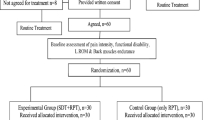Abstract
The therapeutic modalities available for the conservative management of chronic cervical and lumbar pain include underwater traction, the usefulness of which is not universally acknowledged. No reports have been published on clinical trials evaluating underwater traction. This study was intended to ascertain any beneficial impact of weightbath therapy on the clinical parameters and quality of life of patients with cervical/lumbar discopathy. The study population comprised 72 subjects. Two groups of 18 patients each received underwater traction therapy of the cervical or lumbar spine with add-on McKenzie exercises and iontophoresis. The remaining two groups, treated with exercises and iontophoresis, served as controls. VAS and SF36 scores, range of motion were monitored to appraise therapeutic efficacy in cervical discopathy, whereas these parameters were supplemented by the Oswestry index in lumbar discopathy. A MRI scan was done at baseline and after 3 months of follow-up. Underwater cervical or lumbar traction therapy for discopathy achieved significant improvement of all study parameters, which was still evident 3 months later. Among the controls, significant improvement of just a single parameter was seen in patients with lumbar, and of two parameters in those with cervical discopathy. Underwater traction therapy effectively mitigates pain, enhances joint flexibility, and improves the quality of life of patients with cervical or lumbar discopathy. The equipment required to administer weightbath therapy is simple to install and treatment technique is straightforward.

Similar content being viewed by others
References
Koes BW, Van Tulder MW, Thomas S (2006) Diagnosis and treatment of low back pain. BMJ 332:1430–1434
Van Tulder M (2002) Low back pain. Best Pract Res Clin Rheumatol 16:761
Hicks GS, Duddleston DN, Russell LD, HolmanHE, Shepherd JM, Brown CA (2002) Low back pain. Am J Med Sci 324:207–211
Foster NE, Thompson KA, Baxter GD, Allen JM (1999) Management of nonspecific low back pain by physiotherapists in Britain and Ireland. Spine 24:1332–1342
Li LC, Bombardier C (2001) Physical therapy management of low back pain: an exploratory survey of therapist approaches. Phys Ther 81:1018–1027
Jette AM, Delitto A (1997) Physical therapy choices for musculoskeletal improvements. Phys Ther 77:145–154
Aker PD, Gross AR, Goldsmith CH, Peloso P (1996) Conservative management of mechanical neck pain: systematic overview and meta-analysis. BMJ 313:1291–1296
Harte AA, Baxter GD, Gracey JH (2003) The efficacy of traction for back pain: a systematic review of randomized controlled trials. Arch Phys Med Rehabil 84:1542–1553
van der Heijdan GJ, Beurskens AJ, Koes BW, Assendelft WJ, de Vet HC, Bouter LM (1995) The efficacy of traction for back and neck pain: a systematic, blinded review of randomised clinical trial methods. Phys Ther 75:93–104
Moll K (1953) Treatment of discushernia with so-called “weightbath” therapy. Orv Hetil 94:292–296; (in Hungarian)
Bene É (1988) Das Gewichtbad, Zeitschrift für Physikalische Medizin, Balneologie, medizinische Klimatologie 17(2):67–71
Machado LA, de Souza MS, Ferreira PH, Ferreira ML (2006) The McKenzie method for low back pain: a systematic review of the literature with a meta-analysis approach. Spine 20:54–62
Constantoyannis C, Konstantinou D, Kourtopoulos H, Papadakis N (2002) Intermittent cervical traction for cervical radiculopathy caused by large-volume herniated disks. J Manipulative Physiol Ther 25:188–192
Beurskens AJ, de Vet HC, Koke AJ, Lindeman E, Regtop W, van der Heijden GJ, Knipschild PG (1995) Efficacy of traction for non-specific low back pain: a randomised clinical trial. Lancet 346:1596–1600
Clarke JA, van Tulder MW, Blomberg SEI, de Vet HCW, van der Heijden GJMG, Bronfort G (2005) Traction for low-back pain with or without sciatica. Cochrane Datab Syst Rev (4) Art. No. CD003010
Van Tulder MW, Koes B, Malmivaara A (2006) Outcome of non-invasive treatment modalities on back pain: an evidence-based review. Eur Spine J 15(suppl 1):64–81
Greeenberg MS (2001) Handbook of Neurosurgery, 5th edn. Thieme, Stuttgart
Philadelphia Panel (2001) Philadelphia Panel evidence-based clinical practice guidelines on selected rehabilitation interventions for low back pain. Phys Ther 81:1641–1674 (see comments)
Wessel T, van Tulder M, Sigl T, Evert T, Limm H, Stucki G (2006) What predicts outcome in non-operative treatments of chronic low back pain? A systematic review. Eur Spine J 15:1633–1644
Buchner M, Zahlten-Hinguranage A, Schiltenwolf M, Neubauer E (2006) Therapy outcome after multidisciplinary treatment for chronic neck and chronic low back pain: a prospective clinical study in 365 patients. Scand J Rheumatol 35:363–367
Konrad K (1994) The way forward for balneotherapy. Br J Rheumatol 33:301
Konrad K, Tatrai T, Hunka A, Vereckei E, Korondi I (1992) Controlled trial of balneotherapy in treatment of low back pain. Ann Rheum Dis 51:820–822
Posner J, Glew C (2002) Neck Pain. Ann Intern Med 136:758–759
Whitehurst DG, Lewis M, Yao GL, Bryan S, Raftery JP, Mullis R, Hay EM (2007) A brief pain management program compared with physical therapy for low back pain: results from an economic analysis alongside a randomized clinical trial. Arthritis Rheum 57:466–473
Bene E, Kurutz M (1993) Weightbath and its biomechanics. Orv Hetil 134:1123–1129
Kurutzne KM, Bene E, Lovas A, Molnar P, Monori E (2002) Biomechanical experiments for measuring traction lengthening of the lumbar spine during weightbath therapy. Orv Hetil 143:673–684
Kurutz M, Bene E, Lovas A (2003) In vivo deformability of human lumbar spine segments in pure centric tension, measured during traction bath therapy. Acta Bioeng Biomech 5:67–92
Kurutz M (2006) Age-sensitivity of time-related in vivo deformability of human lumbar motion segments and discs in pure centric tension. J Biomech 39:147–157
Author information
Authors and Affiliations
Corresponding author
Rights and permissions
About this article
Cite this article
Oláh, M., Molnár, L., Dobai, J. et al. The effects of weightbath traction hydrotherapy as a component of complex physical therapy in disorders of the cervical and lumbar spine: a controlled pilot study with follow-up. Rheumatol Int 28, 749–756 (2008). https://doi.org/10.1007/s00296-008-0522-y
Received:
Accepted:
Published:
Issue Date:
DOI: https://doi.org/10.1007/s00296-008-0522-y




